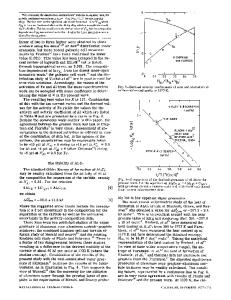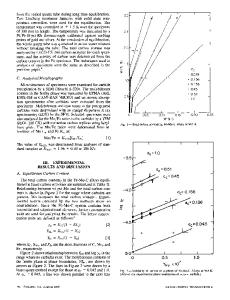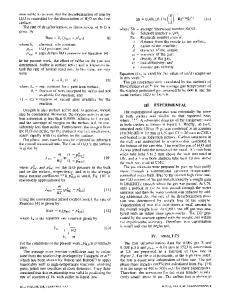A reassessment of the activity of chromium in the Fe-Cr-O system at 1873 K
- PDF / 941,562 Bytes
- 4 Pages / 603.28 x 783.28 pts Page_size
- 20 Downloads / 289 Views
J.M.A. GELDENHUIS, Principal Research Officer, is with the research and Development Department, Iscor Ltd., Pretoria 0001, republic of South Africa. R.J. DIPPENAAR, Professor in the Iscor 2hair, is with the Department of Materials Science and Metallurgical ~ngineering, University of Pretoria, Pretoria 0002, Republic of South kfrica. Manuscript submitted April 22, 1991. METALLURGICAL TRANSACTIONSB
1873 K. A 20-g mixture containing 16 pct SIO2, 16 pet CaO, and 68 pct CrO by mass was prepared by mixing the appropriate quantities of oxide powders under acetone in an agate mortar. The powders were allowed to dry and were then placed with 90 g of an Fe-Cr alloy containing 5 or 25 pct Cr in the Cr203 crucible. Great care was taken to ensure that no slag entered the Cr203 tube. The oxygen-concentration cells and silica-sampling tubes could be dipped through the Cr203 tube directly into the melt, thereby preventing contact with the corrosive liquid slag. Additions of Fe-Cr or Fe were periodically made to change the composition of the alloy, as described previously/41 Previous researchers t8,9,1~ have shown that at 1873 K, stoichiometric Cr203 is in equilibrium with Fe-Cr alloys containing 5 to 25 pct Cr. Consequently, the oxygen potential of an Fe-Cr alloy in equilibrium with solid Cr203 is determined by the following metal-oxide equilibrium: 3 2(Cr} + 2 [O21 = (Cr203}
[1]
where ( ) and [ ] denote the solid and gas phases, respectively. The electrochemical cell used in the present study was arranged as follows: (+) Mo/(FeCr)~oy + Cr203/ZrOE-MgO / (Cr + Cr203)ref/Mo (--) For this cell, tH,121 RT E = - - In F
1/4 [(Po2)alIoy + (Pe)1/4]
l
-?-
t2]
where
E = electromotive force; gas constant; F = Faraday constant; T = absolute temperature; (Po2)~,o, and (Po2)~ = partial pressures of oxygen of the Fe-Cr alloy and the (Cr + Cr203) reference electrode, respectively; and Pe = partial pressure of oxygen at which the n-type electronic conductivity and the ionic conductivity of the solid electrolyte are equal. R=
So that the results of the present investigation could be compared with those of previous workers, tL31the Raoultian chromium activity (aRr) of the Fe-Cr alloy was calculated with reference to pure solid chromium as the standard state. Accordingly, by expanding Eq. [1] for both electrodes and by substituting the applicable oxygen potentials in Eq. [2], the following expression was derived:
~ e(EF/RT)[(eaG~
aca~: [
1/6 + (pe) 1/4] - (pe)l/4~ -3
(e~)~Tg
j
[3]
The term AG ~ is the standard free energy change for the reaction depicted by Eq. [1] and has a value u31 of - 6 . 5 1 7 0 4 • 105 J / m o l at 1873 K. The P, value of the solid electrolyte (ZrO2 stabilized with 9 mol pct MgO) Was determined earlier c4,14j and has a value of 3.077 • 10 -~4 atm. VOLUME 22B, DECEMBER 1991--915
Table I. Raouitian Chromium Activities of Fe-Cr Alloys Contained in a Cr203 Crucible in Equilibrium with Pure Cr203 and a (Cr203(~t)-SiO2-CaO) slag at 1873 K Sample Number
Cell Potential (mV)
Cr (Pet)
Pure Cr203 1.1 (D) 23.1 1.2 (D
Data Loading...











